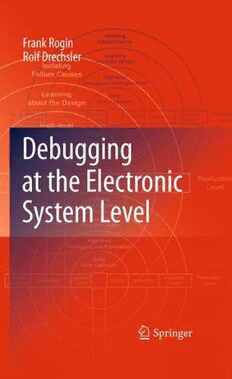Download Debugging at the Electronic System Level PDF Free - Full Version
Download Debugging at the Electronic System Level by Frank Rogin, Rolf Drechsler (auth.) in PDF format completely FREE. No registration required, no payment needed. Get instant access to this valuable resource on PDFdrive.to!
About Debugging at the Electronic System Level
Debugging becomes more and more the bottleneck to chip design productivity, especially while developing modern complex integrated circuits and systems at the Electronic System Level (ESL). Today, debugging is still an unsystematic and lengthy process. Here, a simple reporting of a failure is not enough, anymore. Rather, it becomes more and more important not only to find many errors early during development but also to provide efficient methods for their isolation. In Debugging at the Electronic System Level the state-of-the-art of modeling and verification of ESL designs is reviewed. There, a particular focus is taken onto SystemC. Then, a reasoning hierarchy is introduced. The hierarchy combines well-known debugging techniques with whole new techniques to improve the verification efficiency at ESL. The proposed systematic debugging approach is supported amongst others by static code analysis, debug patterns, dynamic program slicing, design visualization, property generation, and automatic failure isolation. All techniques were empirically evaluated using real-world industrial designs. Summarized, the introduced approach enables a systematic search for errors in ESL designs. Here, the debugging techniques improve and accelerate error detection, observation, and isolation as well as design understanding.
Detailed Information
| Author: | Frank Rogin, Rolf Drechsler (auth.) |
|---|---|
| Publication Year: | 2010 |
| ISBN: | 9789048192540 |
| Pages: | 220 |
| Language: | English |
| File Size: | 2.717 |
| Format: | |
| Price: | FREE |
Safe & Secure Download - No registration required
Why Choose PDFdrive for Your Free Debugging at the Electronic System Level Download?
- 100% Free: No hidden fees or subscriptions required for one book every day.
- No Registration: Immediate access is available without creating accounts for one book every day.
- Safe and Secure: Clean downloads without malware or viruses
- Multiple Formats: PDF, MOBI, Mpub,... optimized for all devices
- Educational Resource: Supporting knowledge sharing and learning
Frequently Asked Questions
Is it really free to download Debugging at the Electronic System Level PDF?
Yes, on https://PDFdrive.to you can download Debugging at the Electronic System Level by Frank Rogin, Rolf Drechsler (auth.) completely free. We don't require any payment, subscription, or registration to access this PDF file. For 3 books every day.
How can I read Debugging at the Electronic System Level on my mobile device?
After downloading Debugging at the Electronic System Level PDF, you can open it with any PDF reader app on your phone or tablet. We recommend using Adobe Acrobat Reader, Apple Books, or Google Play Books for the best reading experience.
Is this the full version of Debugging at the Electronic System Level?
Yes, this is the complete PDF version of Debugging at the Electronic System Level by Frank Rogin, Rolf Drechsler (auth.). You will be able to read the entire content as in the printed version without missing any pages.
Is it legal to download Debugging at the Electronic System Level PDF for free?
https://PDFdrive.to provides links to free educational resources available online. We do not store any files on our servers. Please be aware of copyright laws in your country before downloading.
The materials shared are intended for research, educational, and personal use in accordance with fair use principles.

